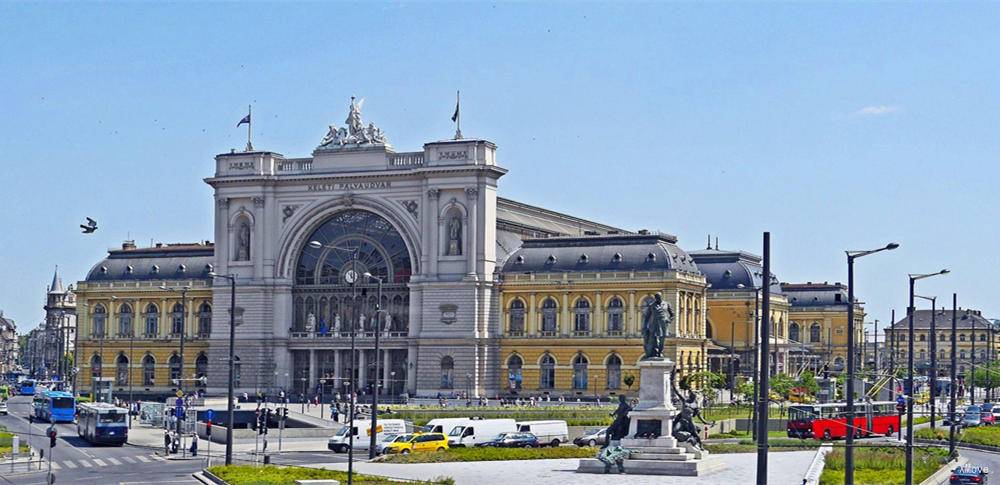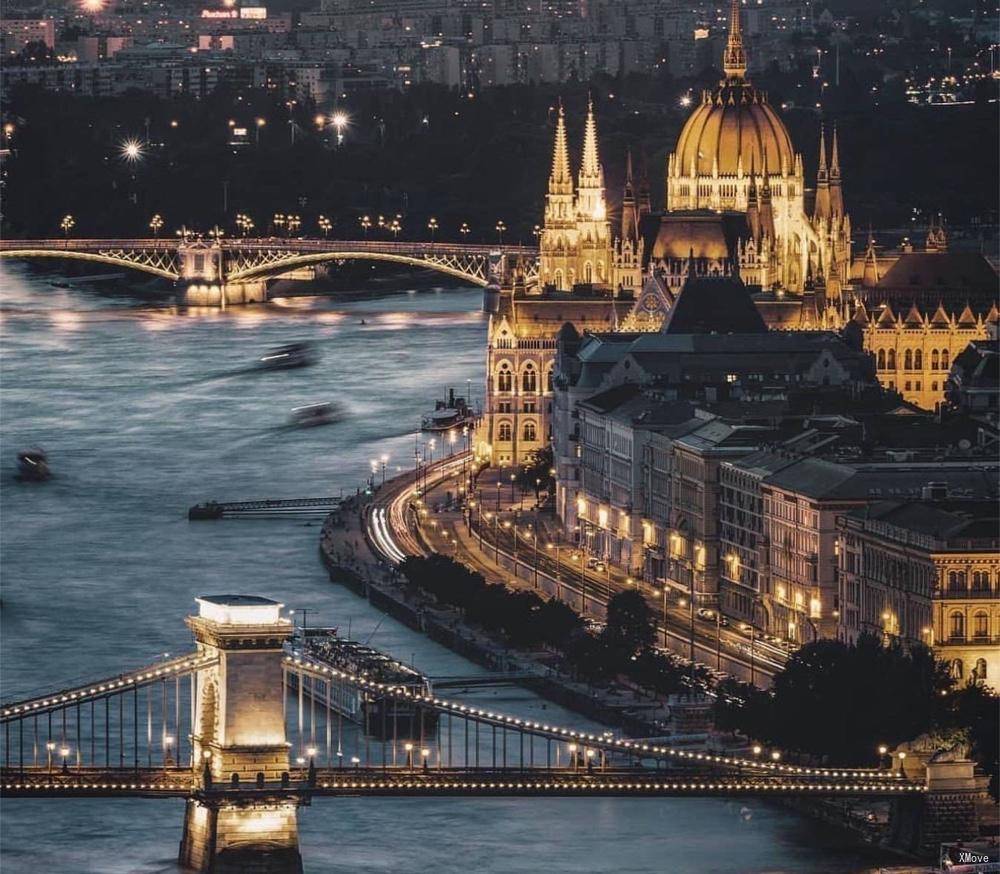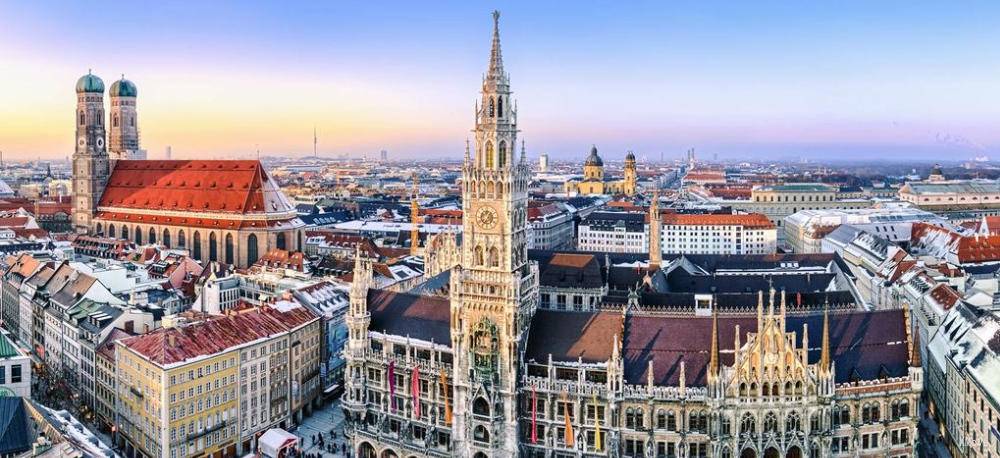Budapest Central to Muenchen Hbf: Trains, Buses, Fares, Today's Connections, Routes, Duration, Types of Trains, Station Guides, Tips, Journey
Hungary Train Tickets
Scan QR code, download App to see Budapest Central's more live update, station guide, plan and photos



Train schedule Budapest Central(Budapest Keleti Pályaudva) to Muenchen Hbf(München Hbf)
Popular train routes departing from Budapest Central(Budapest Keleti Pályaudva)
* Sofia
* Split
* Prague Central(Praha Hlavní Nádraží (Prag Hl. N.))
* Vienna Erdberg (U3)(Wien Erdberg (U3))
* Innsbruck Central(Innsbruck Hbf)
* Vienna Airport(Wien Flughafen)
* Graz Central(Graz Hbf)
Popular train routes arriving in Budapest Central(Budapest Keleti Pályaudva)
* ズパンジャ(Zupanja)
* ベオグラード(Beograd)
* ソフィア(Sofia)
* ゲッピンゲン(Göppingen)
* ランドシュトゥール(Landstuhl)
* ローゼンハイム(Rosenheim)
* リンツ中央駅(Linz Hbf)
Popular train routes departing from Muenchen Hbf(München Hbf)
* Meerbusch Osterath
* Prague Central(Praha Hlavní Nádraží (Prag Hl. N.))
* Rome Termini Central(Roma Termini)
* Luzern
* Utrecht Centraal
* Klagenfurt Central(Klagenfurt Hbf)
* Saarbruecken Hbf(Saarbrücken Hbf)
Popular train routes arriving in Muenchen Hbf(München Hbf)
* Praha Hlavní Nádraží (Prag Hl. N.)
* Praha Hl.N. (Autobusová St. Wilsonova)
* Genève Gare Cornavin
* Neuss Hbf
* Mühlheim(Main)
* Dworzec Centralny W Düsseldorfie(Düsseldorf Hbf)
* Aarhus
* Dworzec Centralny W Berlinie (Głęboki)(Berlin Hbf (Tief))
* Rzym Termini(Roma Termini)
* Salzburg Central Station(Salzburg Hbf)
* Praha Hlavní Nádraží (Prag Hl. N.)
* Lotnisko We Frankfurcie (M)(Frankfurt(M)Flughafen)
* Dworzec Główny W Lipsku(Leipzig Hbf)
* Oeventrop

Budapest Central
The train connects Budapest with all the central and eastern countries of Europe. Unless otherwise indicated, all trains will arrive at Budapest Keleti pályaudva, so if you arrive in Budapest by train, you should get off at East Railway Station. All international trains depart from the Keleti station, and domestic trains to Miskolc, Eger, Győr and Szombathely also depart from here.
You can choose to take the M2 line and get off at the Keleti pályaudvar stop. The starting point of Metro Line 4, the subway M2 and M4 meet here.
Budapest Central - Station Guide | Departures and Arrivals | Popular RoutesMuenchen Hbf
Introduction
München Hauptbahnhof (München Hbf)** is a railway station in Munich, the capital of Bavaria, Germany. Munich has only one main station, a large modern station called Munich Central Station, and almost all trains serve the city. Hauptbahnhof refers only to the main station, which is usually abbreviated as Hbf. Some trains stop at Munich East Station or Munich Pasing on their way to or from Munich's main train station.
Hot Routes
Munich Central Station is a major railway hub, whether it is from London to Budapest, from Amsterdam to Zagreb, or from* Berlin * to Rome, you will often change trains here. The station has 32 and 2 lines to the ground and underground, and its number of tracks is the highest in Germany, making it the most frequently used station in Germany.
The surrounding
Munich Main Station is located in the north of the suburb of Isar, on the outskirts of Ludwig, west of the old city of Munich. From the main entrance on the east side of the station you can reach Karlsplatz via Prielmayerstraße or Bayerstraße. There are a number of tram routes stopping at the station square in front of the main entrance. The station is adjacent to Arnulfstraße in the north and to the Paul-Heyse-Straße via a station tunnel at the platform end. The south of the station is bordered by Bayer Street. The station boundary extends further west and ends at the Donnersberg Bridge.
Inside station
Due to the large area of the station in the train station, it may take a long time for passengers to walk between individual station sections. Deutsche Bahn proposes that in order to ensure a smooth transfer, it is necessary to reserve 10 minutes between the wing station and the central lobby, 15 minutes between the two wing stations, and at the fast railway station to the Starnberg wing station. A 10 minute reservation is required between them and a 15 minute walk between the station and the Holtzkirchen station. There are several dining outlets, newsstands, flower shops and gift shops on the ground and upper floors inside the central lobby. Similarly, there is a large shopping gallery on the ground floor in the north and east, and you can directly access the adjacent city department store through the shopping gallery. From the station you can easily walk to Munich's Cathedral or the main pedestrian square Marienplatz in the heart of Munich. It is a 16-minute walk (1.3 km) from the station to Marienplatz. Most of the pedestrian streets are pedestrian shopping streets.
Platform Introduction
- 1-4: Underground S-Bahn Station, referred to as “MünchenHbf(tief)”
- 5-10: South Wing or Holzkirchener Wing Station, known as “MünchenHbfGl.5-10, enter through the platform 11 from the main track hall 11-26: the main track hall, known as "MünchenHbf"
- 27-36: North Wing or Starnberger Wing Station, known as MünchenHbfGl.27-36 From the main track hall through the platform 26. However, it can also be accessed directly from the S-Bahn station. Regional trains to Füssen (Neuschwanstein, Neuschwanstein) are sent from here. The platform of the wing station is shorter than the main track and can only be used for regional trains.
### Station Lounge
If you have a first class train ticket, you can use the excellent DB first class lounge. Free WiFi, tea, coffee, beer, wine and snacks are available. You can find a similar lounge at other major stations in Germany. The entrance is located in the main square near the northeast corner, the lounge is on the first floor and follow signs to the DB Lounge. If you need to drop your luggage, there are plenty of luggage lockers. There are ATMs in every place. WiFi is available at the station and the first 30 minutes are free.

Budapest (, Hungarian pronunciation: [ˈbudɒpɛʃt]) is the capital and the most populous city of Hungary, and the tenth-largest city in the European Union by population within city limits. The city has an estimated population of 1,752,286 over a land area of about 525 square kilometres (203 square miles). Budapest is both a city and county, and forms the centre of the Budapest metropolitan area, which has an area of 7,626 square kilometres (2,944 square miles) and a population of 3,303,786, comprising 33% of the population of Hungary.The history of Budapest began when an early Celtic settlement transformed into the Roman town of Aquincum, the capital of Lower Pannonia. The Hungarians arrived in the territory in the late 9th century. The area was pillaged by the Mongols in 1241. Buda, the settlements on the west bank of the river, became one of the centres of Renaissance humanist culture by the 15th century. The Battle of Mohács, in 1526, was followed by nearly 150 years of Ottoman rule. After the reconquest of Buda in 1686, the region entered a new age of prosperity. Pest-Buda became a global city with the unification of Buda, Óbuda, and Pest on 17 November 1873, with the name 'Budapest' given to the new capital. Budapest also became the co-capital of the Austro-Hungarian Empire, a great power that dissolved in 1918, following World War I. The city was the focal point of the Hungarian Revolution of 1848, the Battle of Budapest in 1945, and the Hungarian Revolution of 1956.Budapest is an Alpha − global city with strengths in commerce, finance, media, art, fashion, research, technology, education, and entertainment. It is Hungary's financial centre and was ranked as the second fastest-developing urban economy in Europe. Budapest is the headquarters of the European Institute of Innovation and Technology, the European Police College and the first foreign office of the China Investment Promotion Agency. Over 40 colleges and universities are located in Budapest, including the Eötvös Loránd University, the Semmelweis University and the Budapest University of Technology and Economics. Opened in 1896, the city's subway system, the Budapest Metro, serves 1.27 million, while the Budapest Tram Network serves 1.08 million passengers daily.Among Budapest's important museums and cultural institutions is the Museum of Fine Arts. Further famous cultural institutions are the Hungarian National Museum, House of Terror, Franz Liszt Academy of Music, Hungarian State Opera House and National Széchényi Library. The central area of the city along the Danube River is classified as a UNESCO World Heritage Site and has several notable monuments, including the Hungarian Parliament, Buda Castle, Fisherman's Bastion, Gresham Palace, Széchenyi Chain Bridge, Matthias Church and the Liberty Statue. Other famous landmarks include Andrássy Avenue, St. Stephen's Basilica, Heroes' Square, the Great Market Hall, the Nyugati Railway Station built by the Eiffel Company of Paris in 1877 and the second-oldest metro line in the world, the Millennium Underground Railway. The city also has around 80 geothermal springs, the largest thermal water cave system, second largest synagogue, and third largest Parliament building in the world. Budapest attracts 4.4 million international tourists per year, making it a popular destination in Europe.
Budapest - Guide, Attractions, Tours, Sightseeings | Train from/to Budapest | Popular RoutesMunich
City Overview
Munich was the third largest city in Germany, the state capital of Bavaria and the largest city. It was built in 1158. It is not only a high-tech central city, but also a major financial city in Germany and even in the world. Munich has a very long history and cultural tradition, not only rich in artistic life, but also pays great attention to the protection of traditional folk customs and cultural relics. In Munich, museums, galleries and theatres are located throughout the city. Most of them are concentrated in the heart of the old city, the most famous of which are the Deutsches Museum, the new and old painting gallery. In addition, the annual Munich Oktoberfest is also known as Munich's most important folk festival, attracting a large number of visitors from all over the world.
Must visit attractions
- ##### Munich Marienplatz Marienplatz
Munich's Marienplatz is the heart of Munich and is therefore a place for travellers. Before 1807, there was a market in Marien Square. Most of the buildings around the square today were built in the 19th and 20th centuries. There is a pillar of the Virgin in the middle of the square, expressing the gratitude and love of the Virgin Mary. There is a fish spring in the northeast corner of the square. In the past, it was the place where the butcher apprentices held the ceremony. The northwest of Marienplatz is the Marion Church, the new town hall is on the north side of the Marion Square, the Old Town Hall is on the east side of the square, and the Viktor Arian Market is on the southeast side of the square.
Transportation: From the train station, follow Bayerstr Street all the way to the east, then go straight to the east along Karlsplatz and walk along the pedestrian street. Take the city railways S1 to S8 or the U3/U6 metro line to Marienplatz. * ##### Munich New Town Hall Neues Rathaus
The new town hall in Munich was completed in three phases and the construction period lasted from 1867 to 1904. The clock tower on the west side of the new town hall is also one of Munich's most iconic landmarks. At the same time, the bell tower of the New Town Hall is the commanding height of the Old Town Ring Road except the Marion Church. The elevation of other buildings cannot exceed the clock tower. The “Zhongming Dance” on the bell tower is the fourth largest puppet dance in Europe and has a long-standing reputation. Every day at 11 o'clock and 12 o'clock, 17 o'clock, every year from May to October at 17 o'clock and 21 o'clock in the evening, when the small enamel decorated with the brilliance of the upper part of the clock will perform the scene of the knight competition, the lower copper people will perform. The dance of the hoops is very beautiful. Don’t miss the chance to catch up with the time.
Transportation: Light rail/subway: S1/S2/S3/S4/S6/S7/S8/U3/U6 line, Marienplatz station
- ##### BMW Museum
To the north of the Olympic Park, outside the Central Loop is the BMW Munich factory. The famous BMW "four-cylinder building" stands here. The circular building on the west side of the four-cylinder building and its annex building are the BMW Museum, which showcases the development of BMW from the motorcycle and aircraft engine manufacturers to the automotive industry giants.
A very modern building on the west side of the museum is BMW Welt. BMW World is a comprehensive interactive venue that combines display, sales and delivery. On the first floor, BMW's full range of vehicles are on display, and on the second floor, BMW Motorcycle is on display. The car, in addition to a dedicated delivery area, is responsible for delivering the intended vehicle to the customer. The BMW four-cylinder building is an office space and is not open to the public.
Transportation: Take the subway line 3 and get off at the Olympic Center (Olympiazentrum)
- ##### Nymphenburg Palace Schloss Nymphenburg Nymphenburg Palace is located in the west of Munich, built in 1675. In 1644, the prince Ferdinand Maria was happy. To celebrate the birth of the little prince, Wang Hou and his wife ordered the construction of this summer palace in the west of Munich. After more than 300 years of construction, the original ornamental garden has been expanded into a luxurious palace, with baroque gardens, shuttle channels and dotted pavilions. It is a good place to recommend while walking around. The main building of the palace is splendid, and the adjacent buildings on both sides are symmetrical and well-defined. In addition to Nymphenburg Palace, there are three palaces in the Nymphenburg Palace, the Amarin Palace, the Bath Palace and the Pagoda Palace.
Transportation: Bus: Line 51, Schloss Nymphenburg station; Tram: Line 12/17, Schloss Nymphenburg station
Gourmet & Accommodation & Shopping
- ##### Gourmet
Bayern, a large southern state of Germany, everyone prefers to call it Bavaria, where food is everywhere, roast pork knuckles, sausages, large quantities, and beer. Every October at the Oktoberfest, thousands of people will come to the city of beer, so that today's Munich has become synonymous with beer. Convenient transportation, high cost performance Bayern ticket, making it the first choice for many people to go to Germany.
- ##### Accommodation
Munich is the largest city in southern Germany and one of Germany's major economic, cultural, technological and transportation centres. At the same time of development, Munich retains the quaint customs of the former Bavarian capital city. Hotel prices in Munich will rise during the tourist season. The annual Oktoberfest is the most lively season in Munich, so be sure to book the hotel in advance. Most tourists choose to live in the city center and around the train station.
- ##### Shopping
If you are not a historical or architectural enthusiast, nor a tech geek, nor a fanatic, don't be bored, because in Munich, you can have another experience - shopping! One of the key words of the trip to Munich is “crazy shopping”. The threshold for shopping tax refunds in Munich is low and convenient, and the stores are very dense. Famous business districts such as Kuffinger Street, Neuhauserstrasse, Brienna Street, Teetina Street, and Senderinger Street give the traveler an eye-catching satisfaction.
Urban traffic
Munich has a relatively complete public transport system in the city. Urban railways and subways act as the main force of urban traffic. Trams connect the city to the city and the city center. Buses are supplemented by rail transit and are very convenient. If you hold a city travel card, you can use the city's mass transit vehicles within the time limit.
Munich - Guide, Attractions, Tours, Sightseeings | Train from/to Munich | Popular Routes
Hungary Train Tickets
Scan QR code, download App to see Budapest Central's more live update, station guide, plan and photos



Hot Journeys
* Milan -> Lucerne(Luzern)
* Florence -> Rome(Roma)
* Paris -> Nice
* Naples -> Rome(Roma)
* Florence -> Venice(Venezia)
* Venice(Venezia) -> Rome(Roma)
* Berlin(Berlin) -> Munich(Müchen)
* Brussels(Bruxelles) -> Paris
* Barcelona -> Madrid(Madrid)
